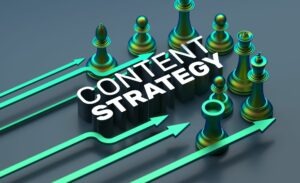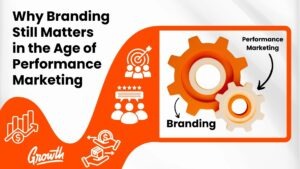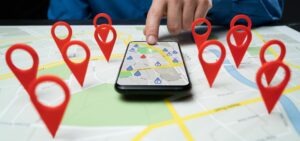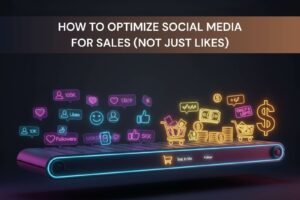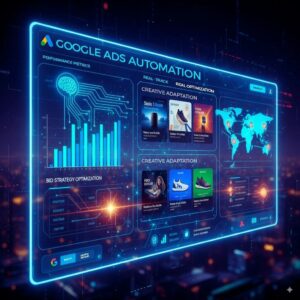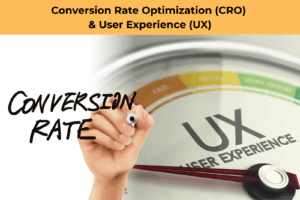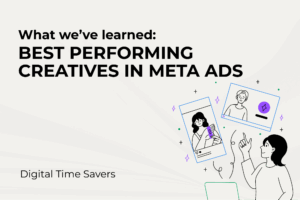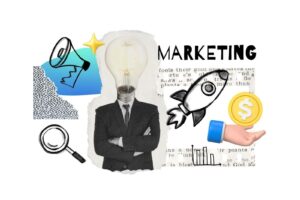Yeah, those days are dead.
Now you’re sitting in another quarterly review, explaining why your CAC just hit triple digits while your conversion rate looks like a typo. Your CFO is asking uncomfortable questions. Your competitors somehow grew 300% doing what looks like the exact same thing you’re doing. And that new performance marketing hire you poached from a competitor? They’re just as confused as you are.
We’ve seen this before. While you were optimizing your bottom-funnel campaigns to perfection, squeezing every last drop of efficiency from your retargeting ads, the game changed. The easy money dried up. The low-hanging fruit got picked clean. And suddenly everyone realized the same thing at the exact same time…we’re all fighting over the same tiny pool of in-market buyers.
It’s like showing up to a gold rush five years late and wondering why you’re only finding dust.
The companies actually winning in 2025 stopped fighting over scraps at the bottom of the funnel. They’re playing three moves ahead, building demand instead of just capturing it, creating customers instead of just converting them. They’re running full-funnel strategies while everyone else is still obsessed with last-click attribution.
And before you roll your eyes and mutter “brand marketing” like it’s a dirty word, this is about math. Cold, hard, CFO-approved math that shows why spending money at the top of the funnel makes your bottom-funnel campaigns print money like it’s 2019 again.
Buckle up. We’re about to show you why your single-channel, BOFU-obsessed strategy is basically burning money, and what the smart money is doing instead.
What Is a Full-Funnel Digital Strategy? (Or: Why You’re Only Fishing in a Puddle)
Every marketing conference has that one slide with the funnel diagram. You know the one…wide at the top, narrow at the bottom, probably in outdated colors from 2015. Everyone nods knowingly. Then they go back to their desks and keep hammering the bottom.
Let’s be real about what a full-funnel strategy actually means, because it’s not just drawing a triangle and calling it a day.
- Top of Funnel (TOFU): The Land of People Who Don’t Know You Exist
This is where 99% of your potential customers live. They’re not searching for your product. They don’t know your brand. They’re just scrolling TikTok in bed or watching YouTube videos about something tangentially related to their problem. Your job here isn’t to sell, it’s to exist in their brain when they’re ready to buy in six months. Think viral TikToks, YouTube pre-rolls that don’t immediately get skipped, display ads that aren’t completely forgettable, and SEO content that actually answers questions instead of keyword-stuffing your product name fifteen times.
- Middle of Funnel (MOFU): The “Maybe” Zone
These people know you exist but aren’t sold yet. They’re comparing, researching, overthinking. They’ve got seventeen browser tabs open and your competitor is in five of them. This is where you prove you’re not just another option but THE option. Email sequences that actually teach something useful. Retargeting that doesn’t feel stalker-ish. Case studies that don’t read like propaganda. Webinars that aren’t just 45-minute sales pitches. You’re building trust, not closing deals.
- Bottom of Funnel (BOFU): Where Everyone Wants to Play
The promised land! High-intent keywords! Shopping campaigns! Retargeting pixels firing everywhere! This is where most of your competition lives because it’s easy to measure and quick to show ROI. But here’s the thing – if this is your only focus, you’re fighting over table scraps while ignoring the feast.
- The Part Everyone Forgets: Post-Purchase
Your customer bought something. Congrats! Now what? Most brands ghost them until next Black Friday. Smart brands turn them into repeat buyers and brand evangelists. Email flows that aren’t just “buy more stuff.” Loyalty programs that actually reward loyalty. Customer service that doesn’t make people want to burn your building down. Because getting a new customer costs 5x more than keeping an existing one, but nobody wants to talk about that in the performance marketing meeting.
The magic isn’t in any single stage. It’s in making them work together like a Swiss watch instead of four different departments that barely talk to each other.
Why Full-Funnel Wins in 2025 (Besides the Obvious “More Money” Part)
Let’s get specific about why the companies running full-funnel strategies are eating everyone else’s lunch while spending less to do it:
1. Your Customers Aren’t Impulse-Buying Ferraris
Unless you’re selling gum at a checkout counter, nobody’s buying at first sight. Research shows people need 7-12 touchpoints before pulling out their credit card. But most marketers are sitting at the finish line wondering why nobody’s crossing it.
Think about your own buying behavior. You saw an ad three months ago, forgot about it, saw an influencer mention it, Googled reviews at midnight, added to cart, abandoned it, saw another ad, asked your friend, then finally bought it using a competitor’s discount code you found on RetailMeNot. That’s the real customer journey…not the neat little line you drew in your presentation.
Full-funnel marketing meets people where they actually are instead of where you wish they were. Because hammering cold audiences with “BUY NOW” is like proposing on a first date. Technically possible, usually disastrous.
2. The Math Finally Caught Up With Everyone
CPCs are up 50% year-over-year. CPMs look like phone numbers. That bottom-funnel campaign that was profitable at $20 CAC is bleeding money at $80 CAC. And guess what? It’s only getting worse as more competitors pile into the same keywords.
Smart money doesn’t fight over expensive bottom-funnel traffic. It creates its own pipeline. Top-of-funnel costs are still relatively cheap because most marketers can’t tie it to immediate ROI. Their loss, your arbitrage opportunity. Build awareness at $2 CPM, nurture at basically nothing through email, convert at higher rates because they actually know who you are. The math is elementary, but apparently, most CMOs failed arithmetic.
3. The Algorithms Are Practically Begging You to Do This
Google, Meta, TikTok…their algorithms are getting scary good at finding buyers. But they need data to work with. Feed them only bottom-funnel conversion data and they optimize for… people already ready to buy. Congratulations, you’ve trained the world’s most sophisticated AI to find the same people everyone else is targeting.
Full-funnel strategies feed the beast properly. Awareness campaigns teach it who engages. Consideration campaigns refine who’s interested. Conversion campaigns identify who buys. Now the algorithm has the full picture instead of just the final frame. Your lookalike audiences get scary accurate. Your targeting improves across the board. The robots want to help you, you just have to speak their language.
4. Brand Equity: The Compound Interest of Marketing
Performance marketing is like renting. You pay, you get customers, you stop paying, customers disappear. Brand building is like owning. Every dollar invested compounds over time.
The problem? Most performance marketers treat brand like it’s some fluffy BS that doesn’t drive revenue. Meanwhile, companies with strong brands are converting at 2-3x industry average and paying half the CAC because people actually search for them by name. But sure, keep telling yourself brand doesn’t matter while you bid against Amazon for generic keywords.
5. The Personalization Revolution Actually Happened (You Just Missed It)
We finally have the tech to show different messages to people at different stages. First-time visitor? Here’s our story. Abandoned cart? Here’s 10% off. Previous customer? Here’s the new product line.
But most companies are still blasting the same “SALE ENDS TONIGHT” message to everyone. It’s like having a Swiss Army knife and only using the toothpick. Full-funnel strategies leverage this tech properly, awareness content for cold audiences, education for warm, offers for hot. Right message, right person, right time. Revolutionary concept, apparently.
Key Components of a Winning Full-Funnel Strategy in 2025 (The Stuff That Actually Matters)
Data & Audience Insights (Stop Guessing Who Your Customers Are)
Real audience insights mean knowing that your actual buyers are 34-year-old project managers who browse Reddit during their 3 PM slump, watch YouTube tutorials at lunch, and make purchase decisions at 9 PM after their kids are asleep. They’ve got 14 tabs open, three of which are your competitors. They trust peer reviews more than ads, but they’ll impulse-buy if you catch them at the right moment with the right message.
Map the actual journey, not the one you wish they took. Because your neat little funnel diagram is cute, but their real path looks like someone dropped a bowl of spaghetti on the floor.
Content That’s Interesting
Different people need different messages at different times. Groundbreaking, right?
Top of funnel isn’t where you talk about your “innovative solutions.” It’s where you make someone laugh, teach them something they didn’t know, or tell a story that makes them feel something. Nobody shares your product features. Everyone shares that video that made them snort coffee.
Middle of funnel is where you prove you’re not full of shit. Case studies that don’t sound like you wrote them yourself. Educational content that actually educates instead of thinly veiled sales pitches. Reviews from real humans, not “John D. from Location, USA.”
Bottom of funnel is where you can finally talk about yourself. But even here, “BUY NOW SALE ENDS” is lazy. Show them exactly what happens after they buy. Remove every tiny friction point. Make the value so obvious that NOT buying feels stupid.
Channel Integration (Stop Making Your Channels Fight Each Other)
Your TikTok team doesn’t talk to your Google Ads team. Your email person has no idea what creative is running on Meta. Your SEO strategy exists in a completely different universe from your paid social. Then you wonder why your marketing feels schizophrenic.
Integrated means your TikTok video becomes your YouTube ad becomes your email gif becomes your landing page hero. Same message, adapted for platform, building momentum instead of starting from scratch every time. When someone sees you on Instagram, then YouTube, then Google, it shouldn’t feel like three different companies with personality disorders.
Measurement That Doesn’t Require a PhD in Analytics
Last-click attribution is like giving all the credit to the person who scored the goal and ignoring everyone else on the team. Multi-touch attribution shows who assisted, who defended, who set up the play.
But here’s the dirty secret: perfect attribution doesn’t exist. iOS 14.5 made sure of that. You’re working with directional data, not perfect information. The companies winning aren’t the ones with the best attribution models – they’re the ones comfortable with ambiguity who test, learn, and adjust faster than their competitors who are still arguing about attribution windows.
Creative That Doesn’t Look Like Everyone Else’s
Every brand is using the same stock footage, the same TikTok trends, the same “problem-agitate-solution” framework they learned from the same YouTube guru. Then they wonder why their ads blend into wallpaper.
Test weird stuff. Make content that could only come from your brand. Stop asking “what’s working for others?” and start asking “what haven’t people seen yet?” Because the moment something works, everyone copies it, and suddenly it doesn’t work anymore.
The brands winning creative aren’t following best practices. They’re creating them.
Case Study Example (Hypothetical But The Info Is Legit)
Let’s say you’re running a D2C skincare brand. Here’s how most companies do it…throw money at Instagram ads featuring dewy models, pray for conversions, panic when CAC hits $150, then blame iOS 14.5 for everything (still).
Here’s how full-funnel actually plays out:
- Top of Funnel: You partner with micro-influencers (not the Kardashians, Karen) to create “get ready with me” content that happens to feature your cleanser. Cost: $500 per creator. Reach: 50K people who actually care about skincare, not just pretty packaging. Nobody’s buying yet, but 500 people just saved that video for later.
- Middle of Funnel: Those 500 people start seeing your content everywhere – not because you’re stalking them (well, not just that), but because you’re running strategic retargeting. Blog posts about “Why Your Skin Freaks Out in Winter” that actually help, not just shill product. YouTube videos showing real results on real skin, not just before/after photos that look like different people. Email sequences that educate, not just scream “SALE SALE SALE.”
- Bottom of Funnel: Now they’re ready. They’ve seen you five times, read your ingredients breakdown, watched three testimonials from people with their exact skin type. That 15% off first-order email hits different when they actually trust you. Your “abandoned cart” message works because they actually wanted the product, not because you tricked them into clicking.
- The Part Everyone Forgets: They bought your cleanser. Great. Now what? Smart brands use purchase data to predict what they’ll need next. Cleanser buyers get serum education two weeks later. Serum buyers learn about moisturizer. Not pushy, just helpful. “Hey, if you’re using our Vitamin C serum, here’s why you need SPF.” Lifetime value doubles because you’re solving problems, not just pushing products.
- The Reality Check: This doesn’t happen overnight. Month one, you’re bleeding money on awareness campaigns with zero return. Month two, your CFO is asking uncomfortable questions. Month three, you start seeing assisted conversions. Month six, your CAC is down 40% and LTV is up 60%. But most companies quit at month two because they can’t see past next week’s ROAS.
The brands that win are the ones patient enough to build a system instead of chasing quick wins.
Challenges to Implementing Full-Funnel Strategies
If full-funnel was easy, everyone would be doing it. But they’re not and that’s your advantage. So why aren’t more brands doing this? Here’s what’s tripping them up:
1. Creative Production Feels Like a Content Treadmill
The TikTok team wants trendy. The YouTube crew wants polished. Your email marketer just wants anything that’s not a Canva screenshot. And suddenly you need 9 versions of the same message for 4 funnel stages across 6 platforms. It’s a lot.
But it’s also the game now. The brands scaling in 2025 aren’t “trying to make content”…they’ve built creative engines. Modular assets. Batch production. Smart repurposing. If your creative process still involves Slack threads titled “Need an idea,” you’re not ready.
2. Tracking Looks Like a Crime Scene
Attribution in 2025 is like chasing a ghost with a flashlight and a blurry security cam. Between iOS updates, cookie death, and cross-device chaos, trying to connect your YouTube view to your Klaviyo open to your Meta purchase looks like a scene from CSI: Marketing.
Yes, it’s messy.
No, you don’t need perfect data to make smart decisions.
The winning brands embrace directional insights, run structured tests, and obsess over LTV/CAC more than channel-by-channel ROI. Meanwhile, your competitor’s stuck yelling at Google Analytics like it’s going to confess.
3. Budget Reallocation Triggers Existential Crises
“We can’t take money from search, it’s working!” Yeah, it’s working… until it doesn’t. Until your CPCs double again. Until your competitors outbid you. Until your audience dries up. Moving budget into TOFU feels risky when your CMO’s bonus depends on this quarter’s ROAS. But the brands playing long-game offense, while others cling to short-term defense, are the ones building true, sustainable growth.
You’re not cutting performance. You’re expanding your pipeline so performance can actually scale.
Yes, full-funnel takes more coordination, more patience, and more brainpower than just hitting “duplicate ad set.” But that complexity is the moat.
Most brands won’t do it. That’s exactly why you should.
The Future of Full-Funnel Marketing
It’s all going to get a whole lot weirder and wilder from here. But don’t worry, it’s not all doom and gloom. It’s going to get easier. At least some of it.
AI is already building dynamic journeys that adapt in real-time. Shoppable videos are turning attention spans into cart sessions. AR/VR is collapsing the gap between “interested” and “sold.” And privacy-first targeting is rewriting the rules on how we reach people in the first place.
What do all these trends have in common? They don’t live neatly in one part of the funnel.
You can’t slap a TikTok ad on the front end, pray for conversions, and call it a strategy. The brands that survive the next five years will be the ones that stop thinking in silos and start thinking in systems.
Full-funnel marketing is how you future-proof your growth.
The Bottom Line
Today, the winners aren’t the ones with the flashiest creative or the lowest CPM. They’re the ones who finally understood that marketing is a relationship, not a transaction.
A full-funnel strategy builds equity. It earns attention, trust, and loyalty. It creates momentum that compounds. It turns $1 into $5 today and into $50 tomorrow.
If building out a full funnel with the right content, targeted ads, and backend systems to convert leads feels like a hassle, you’re not alone.
The good news? You don’t have to figure it out on your own.
The DTS team brings deep experience in designing, launching, and optimizing full-funnel strategies that attract the right people, move them through the journey, and turn them into loyal customers.
Let’s build something that lasts (and converts!). Contact DTS today and let’s map out your full-funnel game plan for 2025 and beyond.



